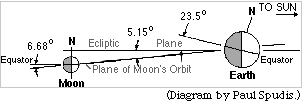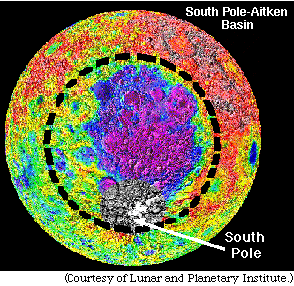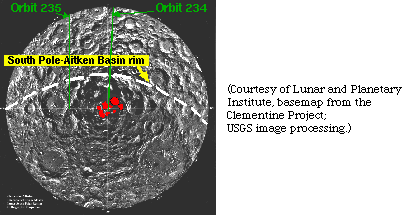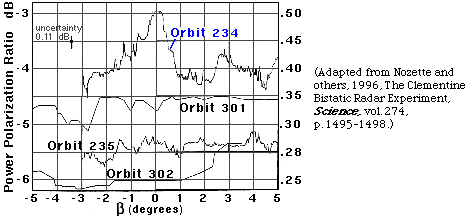|
|
|
|
|
|
|
posted December 21, 1996 |
 | |
| Ice on the Bone Dry Moon Written by Paul D. Spudis Lunar and Planetary Institute, Houston, TX Deputy Leader of the Clementine Science Team | ||
| (NASA photo) | ||
These suspicions appear to be correct (see Nozette, S., Lichtenberg, C.L., Spudis, P.D., Bonner, R., Ort, W., Malaret, E., Robinson, M., and Shoemaker, E.M., 1996, The Clementine Bistatic Radar Experiment, Science, vol. 274, p. 1495-1498). Analysis of data returned from a radio-wave experiment performed in 1994 while the Clementine spacecraft was orbiting the Moon reveals that deposits of ice exist in permanently dark regions near the south pole of the Moon. Initial estimates suggest that the volume of a small lake exists, 1 billion cubic meters. For comparison, this amount of water would be equivalent to the fuel (hydrogen and oxygen) used for more than a million launches of the Space Shuttle from Cape Canaveral!
 |
During the Apollo program, astronauts (such as John Young pictured here) explored the surface of the Moon and brought back 382 kilograms of rock and dirt. These samples are completely devoid of water. In contrast to rocks on Earth, moon rocks contain no water-bearing minerals, such as mica or clays. (NASA photo) |
In the late 1970s, James Arnold of the University of California, San Diego, suggested that impacting comets and water-rich asteroids could add water to the lunar surface. Where would this water end up? Most of it would be split by sunlight into its constituent atoms of hydrogen and oxygen and lost into space, but some would migrate by literally hopping along to places where it is very cold. Arnold speculated that the polar regions might have areas that are permanently shadowed, hence permanently cold. The water might accumulate there.
 |
If you stand on a peak at the pole of the Moon, you would see the Sun constantly, while if you were in a hole, you would never see the Sun. See larger version. (26 K image) |
One of the major discoveries of the Clementine mission was the size and depth of the South Pole-Aitken basin, an impact crater over 2500 kilometers (km) in diameter and up to 13 km deep, the largest and deepest crater in the Solar System. Although this basin is centered at 50o south latitude, it is so large that it encompasses the south pole of the Moon.
 |
This Clementine topographic map of the Moon (red=high, purple=low -- each color equals 500 meters of elevation), shows the extent of the South Pole-Aitken basin. The basin is about 2500 km across and 13 km deep. Note that by chance, the south pole of the Moon falls inside the rim of the basin, leaving large areas in permanent darkness; see next figure. See larger version. (166 K image) |
 |
Two composite images of the lunar poles are shown above. These composite images (made up of many different orbits) show the lighting conditions at the north and south poles of the Moon throughout one lunar day. (One lunar day lasts 29 Earth days.) Note that for the north pole (left image), virtually every area gets some sunlight during some part of the lunar day. However, large areas of the south pole appear to be permanently dark (black on right polar image).
It has been calculated that temperatures in these permanently dark areas may be as cold as 40 to 50 Kelvin (-230o to -220o C), only a few tens of degrees above absolute zero. Moreover, these "cold traps" have existed on the Moon for at least the last 3-4 billion years - plenty of time to accumulate water from impacting comets.
The Clementine team used the radio transmitter aboard the spacecraft to beam radio waves into the dark regions of the south pole of the Moon, into lighted regions of the south pole, and elsewhere on the Moon for comparison.

See larger version. (111 K image)
Echoes of these waves were obtained from the large dish antennas of the Deep Space Network on Earth. The image, above, is a mosaic of the south polar region of the Moon. Permanently dark areas are shown in red. Two radar tracks (in green) are shown for orbits 235 (non-dark region) and orbit 234 (directly over the dark areas). The permanently dark regions around the south pole have the radar reflectance properties of ice, rather than the ground-up rock powder characteristic of the rest of the Moon's surface. Additional data taken on orbits where the reflected radio spots were not over these south polar regions and at the north pole do not show this ice signature.

See larger version. (60 K image)
This graph shows the power of reflected radio energy for four orbits by the Clementine spacecraft plotted against the angle made by lines from the spacecraft to Earth and from the spacecraft to the target on the Moon. Orbits 301 and 302 were data taken over the north pole of the Moon (where very little permanently dark area is seen), while data from orbits 234 and 235 were taken in the vicinity of the south pole. If ice is present, the power should have a distinct "peak" around beta = 0 (the "bicycle reflector" effect), when spacecraft, target, and Earth all are aligned.
The lack of a peak is expected for all but the dark regions on the Moon because they are all illuminated by the Sun during the course of the lunar day. The total area of permanent darkness near the south pole exceeds 15,500 km2, about twice the areal extent of the island of Puerto Rico. The total amount of water is difficult to determine, but using the amount of permanently-shadowed area and the strength of the radar signal, we estimate that the total volume of ice is about 1 km3, an amount of water equivalent to that of a sizable lake.

|
|
[ About PSRD |
Archive |
Search |
Subscribe ] [ Glossary | General Resources | Comments | Top of page ] |